Best Practices for Healthy Home Childcare: A Comprehensive Report
VerifiedAdded on 2023/06/10
|7
|1633
|449
Report
AI Summary
This report discusses how to provide a healthy home-based childcare environment. It emphasizes the importance of maintaining health and safety to minimize risks and prevent harm to children. Key areas covered include preparing formula feeds safely by identifying the correct formula, using proper feeding cups, following written guidelines, and refrigerating prepared food. The report details sterilizing feeding equipment using commercial sterilizers or boiling water to eliminate pathogens. Safe food storage practices are highlighted, such as covering cooked food, storing fruits and vegetables at appropriate temperatures, and using clean, airtight containers for dry food. Hygienic food preparation, including hand washing, clean containers and work surfaces, and avoiding direct contact with food, is stressed. The report also addresses safe reheating of food to prevent germ growth, awareness of food allergies and intolerances, proper waste disposal methods, and ensuring children's safety around pets by restricting pet access to children's rooms and food areas. The conclusion reiterates the significance of these practices in promoting children's well-being and preventing severe illnesses, encouraging a focus on sterilization, hygiene, food preparation, waste disposal, and pet safety to create a healthy home environment for children. Desklib provides solved assignments and resources for students.
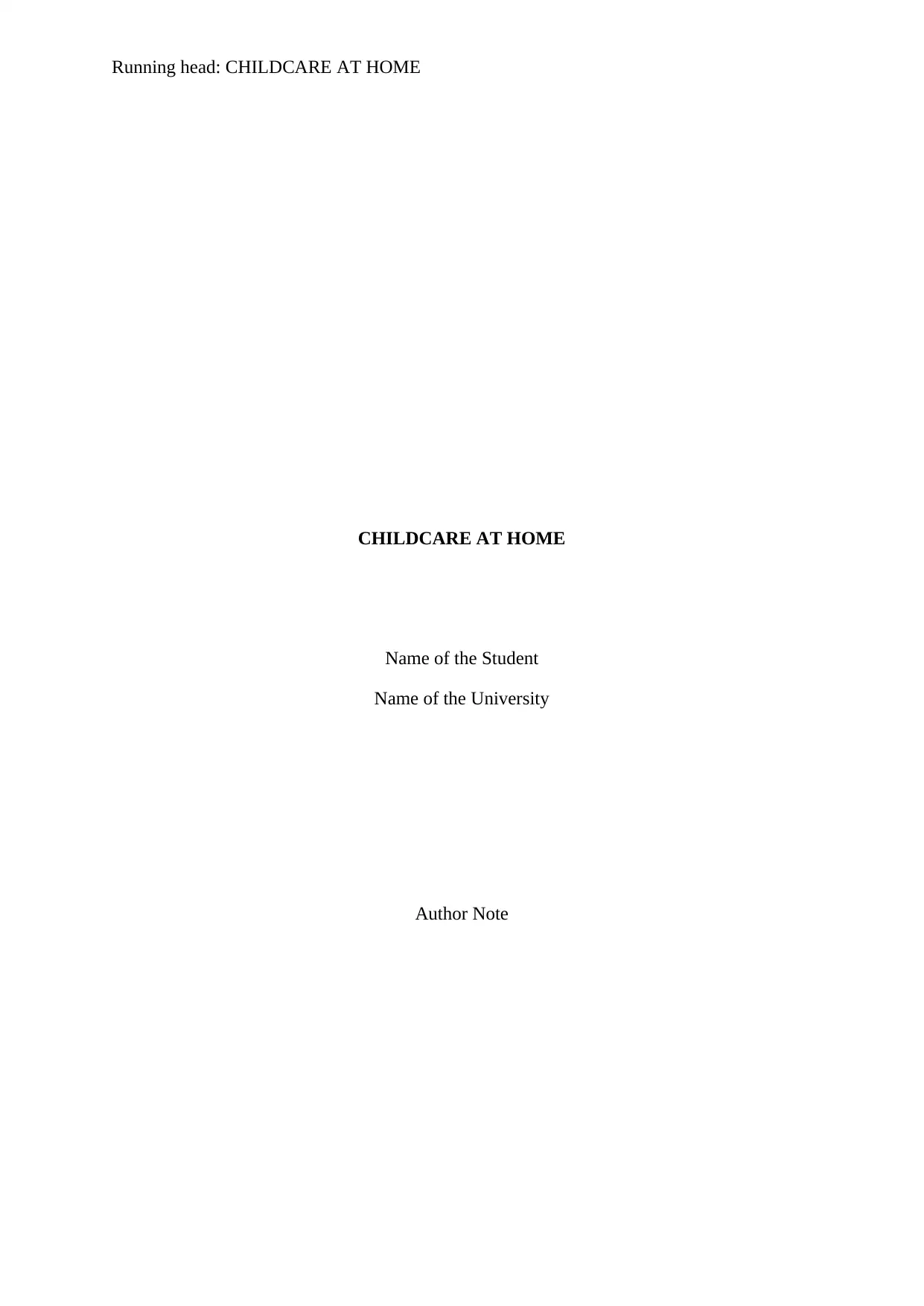
Running head: CHILDCARE AT HOME
CHILDCARE AT HOME
Name of the Student
Name of the University
Author Note
CHILDCARE AT HOME
Name of the Student
Name of the University
Author Note
Paraphrase This Document
Need a fresh take? Get an instant paraphrase of this document with our AI Paraphraser
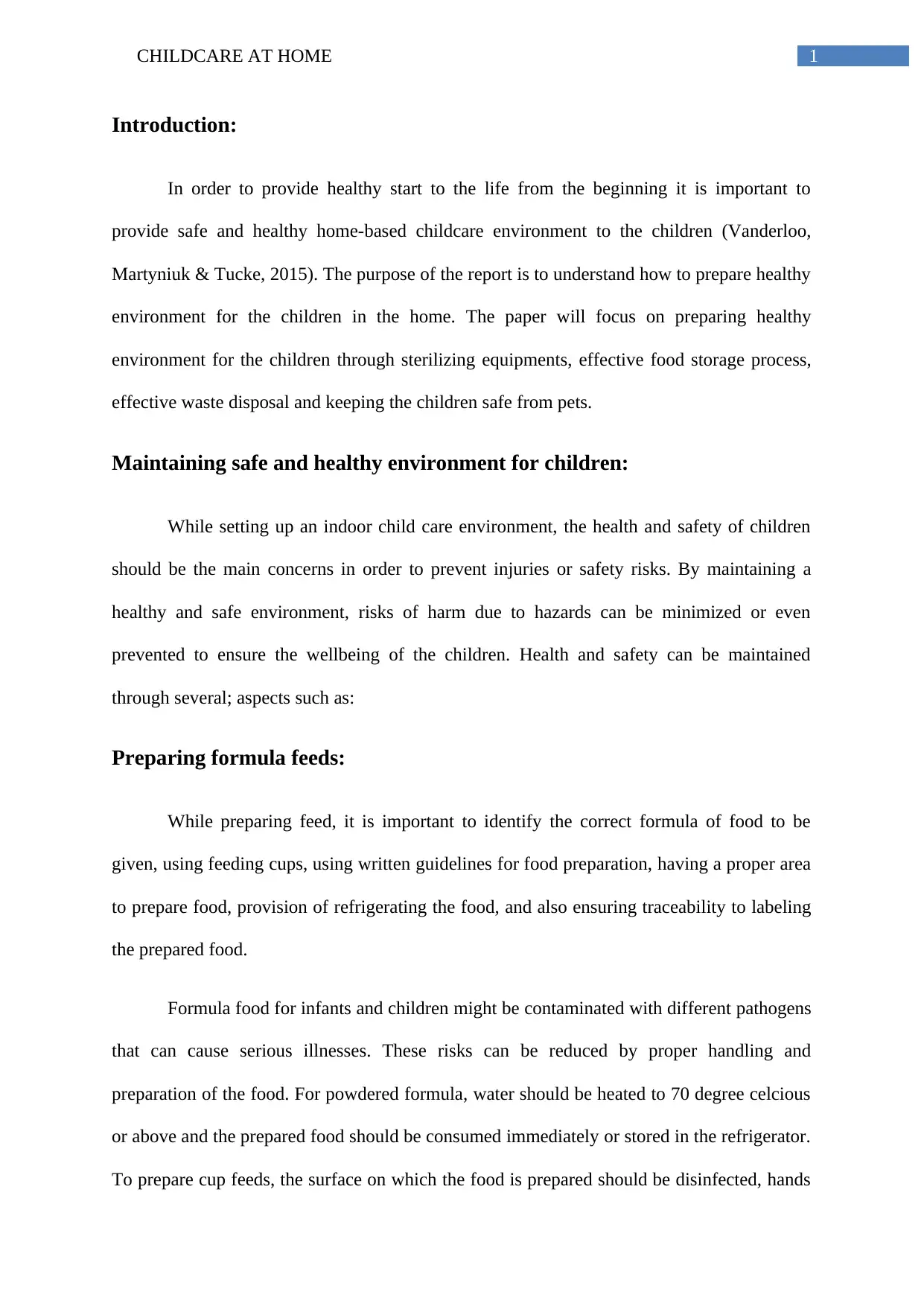
1CHILDCARE AT HOME
Introduction:
In order to provide healthy start to the life from the beginning it is important to
provide safe and healthy home-based childcare environment to the children (Vanderloo,
Martyniuk & Tucke, 2015). The purpose of the report is to understand how to prepare healthy
environment for the children in the home. The paper will focus on preparing healthy
environment for the children through sterilizing equipments, effective food storage process,
effective waste disposal and keeping the children safe from pets.
Maintaining safe and healthy environment for children:
While setting up an indoor child care environment, the health and safety of children
should be the main concerns in order to prevent injuries or safety risks. By maintaining a
healthy and safe environment, risks of harm due to hazards can be minimized or even
prevented to ensure the wellbeing of the children. Health and safety can be maintained
through several; aspects such as:
Preparing formula feeds:
While preparing feed, it is important to identify the correct formula of food to be
given, using feeding cups, using written guidelines for food preparation, having a proper area
to prepare food, provision of refrigerating the food, and also ensuring traceability to labeling
the prepared food.
Formula food for infants and children might be contaminated with different pathogens
that can cause serious illnesses. These risks can be reduced by proper handling and
preparation of the food. For powdered formula, water should be heated to 70 degree celcious
or above and the prepared food should be consumed immediately or stored in the refrigerator.
To prepare cup feeds, the surface on which the food is prepared should be disinfected, hands
Introduction:
In order to provide healthy start to the life from the beginning it is important to
provide safe and healthy home-based childcare environment to the children (Vanderloo,
Martyniuk & Tucke, 2015). The purpose of the report is to understand how to prepare healthy
environment for the children in the home. The paper will focus on preparing healthy
environment for the children through sterilizing equipments, effective food storage process,
effective waste disposal and keeping the children safe from pets.
Maintaining safe and healthy environment for children:
While setting up an indoor child care environment, the health and safety of children
should be the main concerns in order to prevent injuries or safety risks. By maintaining a
healthy and safe environment, risks of harm due to hazards can be minimized or even
prevented to ensure the wellbeing of the children. Health and safety can be maintained
through several; aspects such as:
Preparing formula feeds:
While preparing feed, it is important to identify the correct formula of food to be
given, using feeding cups, using written guidelines for food preparation, having a proper area
to prepare food, provision of refrigerating the food, and also ensuring traceability to labeling
the prepared food.
Formula food for infants and children might be contaminated with different pathogens
that can cause serious illnesses. These risks can be reduced by proper handling and
preparation of the food. For powdered formula, water should be heated to 70 degree celcious
or above and the prepared food should be consumed immediately or stored in the refrigerator.
To prepare cup feeds, the surface on which the food is prepared should be disinfected, hands
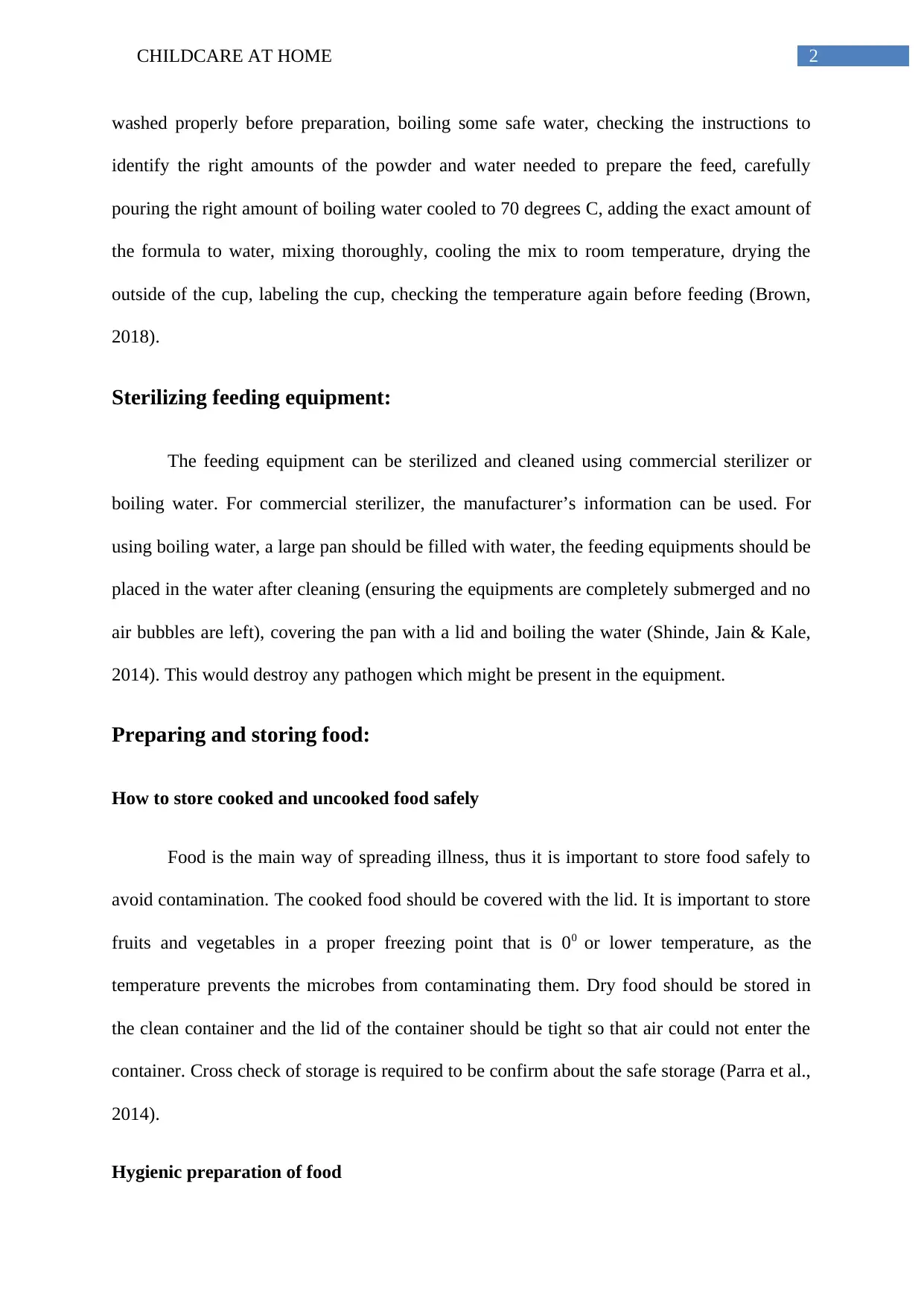
2CHILDCARE AT HOME
washed properly before preparation, boiling some safe water, checking the instructions to
identify the right amounts of the powder and water needed to prepare the feed, carefully
pouring the right amount of boiling water cooled to 70 degrees C, adding the exact amount of
the formula to water, mixing thoroughly, cooling the mix to room temperature, drying the
outside of the cup, labeling the cup, checking the temperature again before feeding (Brown,
2018).
Sterilizing feeding equipment:
The feeding equipment can be sterilized and cleaned using commercial sterilizer or
boiling water. For commercial sterilizer, the manufacturer’s information can be used. For
using boiling water, a large pan should be filled with water, the feeding equipments should be
placed in the water after cleaning (ensuring the equipments are completely submerged and no
air bubbles are left), covering the pan with a lid and boiling the water (Shinde, Jain & Kale,
2014). This would destroy any pathogen which might be present in the equipment.
Preparing and storing food:
How to store cooked and uncooked food safely
Food is the main way of spreading illness, thus it is important to store food safely to
avoid contamination. The cooked food should be covered with the lid. It is important to store
fruits and vegetables in a proper freezing point that is 00 or lower temperature, as the
temperature prevents the microbes from contaminating them. Dry food should be stored in
the clean container and the lid of the container should be tight so that air could not enter the
container. Cross check of storage is required to be confirm about the safe storage (Parra et al.,
2014).
Hygienic preparation of food
washed properly before preparation, boiling some safe water, checking the instructions to
identify the right amounts of the powder and water needed to prepare the feed, carefully
pouring the right amount of boiling water cooled to 70 degrees C, adding the exact amount of
the formula to water, mixing thoroughly, cooling the mix to room temperature, drying the
outside of the cup, labeling the cup, checking the temperature again before feeding (Brown,
2018).
Sterilizing feeding equipment:
The feeding equipment can be sterilized and cleaned using commercial sterilizer or
boiling water. For commercial sterilizer, the manufacturer’s information can be used. For
using boiling water, a large pan should be filled with water, the feeding equipments should be
placed in the water after cleaning (ensuring the equipments are completely submerged and no
air bubbles are left), covering the pan with a lid and boiling the water (Shinde, Jain & Kale,
2014). This would destroy any pathogen which might be present in the equipment.
Preparing and storing food:
How to store cooked and uncooked food safely
Food is the main way of spreading illness, thus it is important to store food safely to
avoid contamination. The cooked food should be covered with the lid. It is important to store
fruits and vegetables in a proper freezing point that is 00 or lower temperature, as the
temperature prevents the microbes from contaminating them. Dry food should be stored in
the clean container and the lid of the container should be tight so that air could not enter the
container. Cross check of storage is required to be confirm about the safe storage (Parra et al.,
2014).
Hygienic preparation of food
⊘ This is a preview!⊘
Do you want full access?
Subscribe today to unlock all pages.

Trusted by 1+ million students worldwide
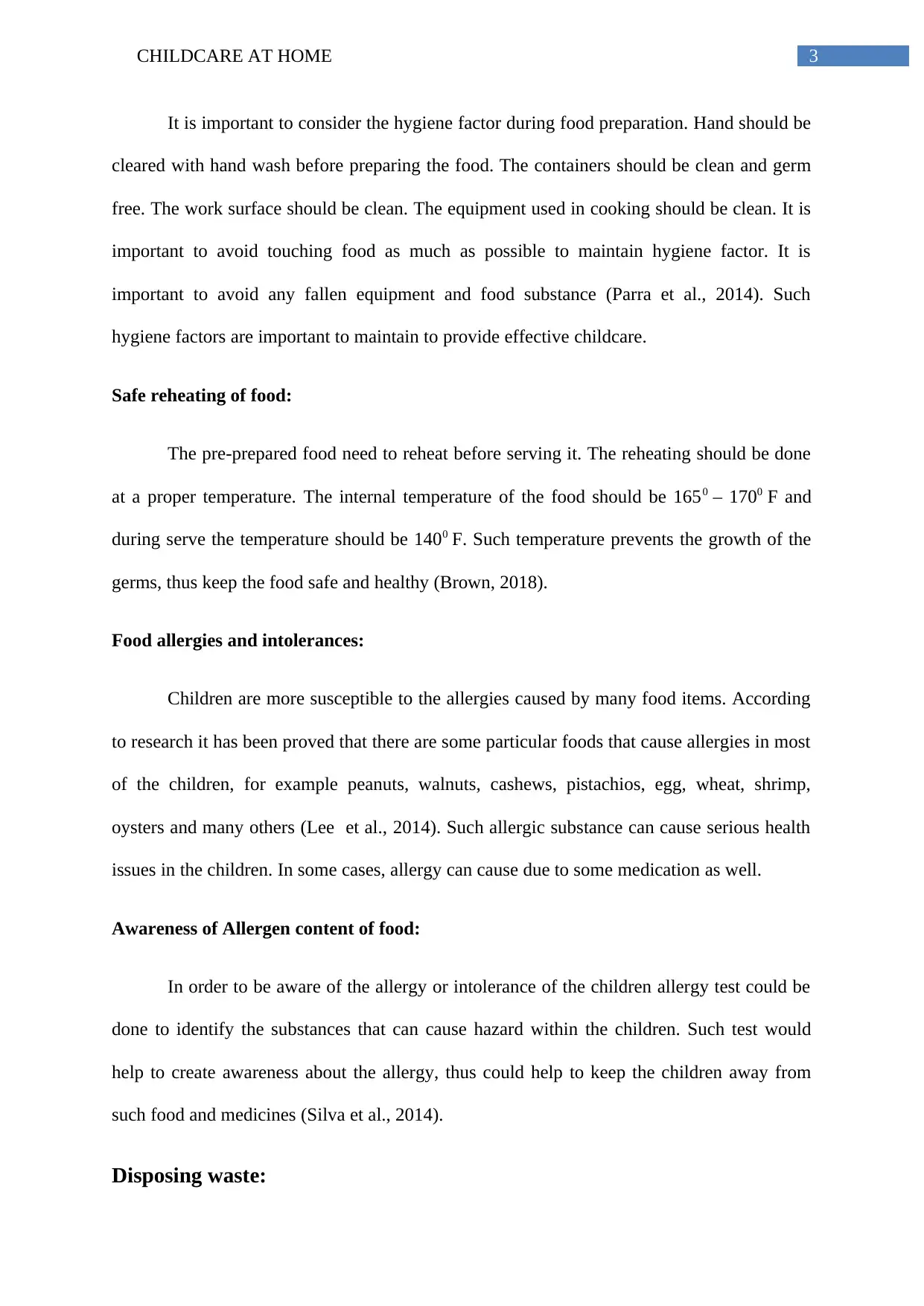
3CHILDCARE AT HOME
It is important to consider the hygiene factor during food preparation. Hand should be
cleared with hand wash before preparing the food. The containers should be clean and germ
free. The work surface should be clean. The equipment used in cooking should be clean. It is
important to avoid touching food as much as possible to maintain hygiene factor. It is
important to avoid any fallen equipment and food substance (Parra et al., 2014). Such
hygiene factors are important to maintain to provide effective childcare.
Safe reheating of food:
The pre-prepared food need to reheat before serving it. The reheating should be done
at a proper temperature. The internal temperature of the food should be 1650 – 1700 F and
during serve the temperature should be 1400 F. Such temperature prevents the growth of the
germs, thus keep the food safe and healthy (Brown, 2018).
Food allergies and intolerances:
Children are more susceptible to the allergies caused by many food items. According
to research it has been proved that there are some particular foods that cause allergies in most
of the children, for example peanuts, walnuts, cashews, pistachios, egg, wheat, shrimp,
oysters and many others (Lee et al., 2014). Such allergic substance can cause serious health
issues in the children. In some cases, allergy can cause due to some medication as well.
Awareness of Allergen content of food:
In order to be aware of the allergy or intolerance of the children allergy test could be
done to identify the substances that can cause hazard within the children. Such test would
help to create awareness about the allergy, thus could help to keep the children away from
such food and medicines (Silva et al., 2014).
Disposing waste:
It is important to consider the hygiene factor during food preparation. Hand should be
cleared with hand wash before preparing the food. The containers should be clean and germ
free. The work surface should be clean. The equipment used in cooking should be clean. It is
important to avoid touching food as much as possible to maintain hygiene factor. It is
important to avoid any fallen equipment and food substance (Parra et al., 2014). Such
hygiene factors are important to maintain to provide effective childcare.
Safe reheating of food:
The pre-prepared food need to reheat before serving it. The reheating should be done
at a proper temperature. The internal temperature of the food should be 1650 – 1700 F and
during serve the temperature should be 1400 F. Such temperature prevents the growth of the
germs, thus keep the food safe and healthy (Brown, 2018).
Food allergies and intolerances:
Children are more susceptible to the allergies caused by many food items. According
to research it has been proved that there are some particular foods that cause allergies in most
of the children, for example peanuts, walnuts, cashews, pistachios, egg, wheat, shrimp,
oysters and many others (Lee et al., 2014). Such allergic substance can cause serious health
issues in the children. In some cases, allergy can cause due to some medication as well.
Awareness of Allergen content of food:
In order to be aware of the allergy or intolerance of the children allergy test could be
done to identify the substances that can cause hazard within the children. Such test would
help to create awareness about the allergy, thus could help to keep the children away from
such food and medicines (Silva et al., 2014).
Disposing waste:
Paraphrase This Document
Need a fresh take? Get an instant paraphrase of this document with our AI Paraphraser
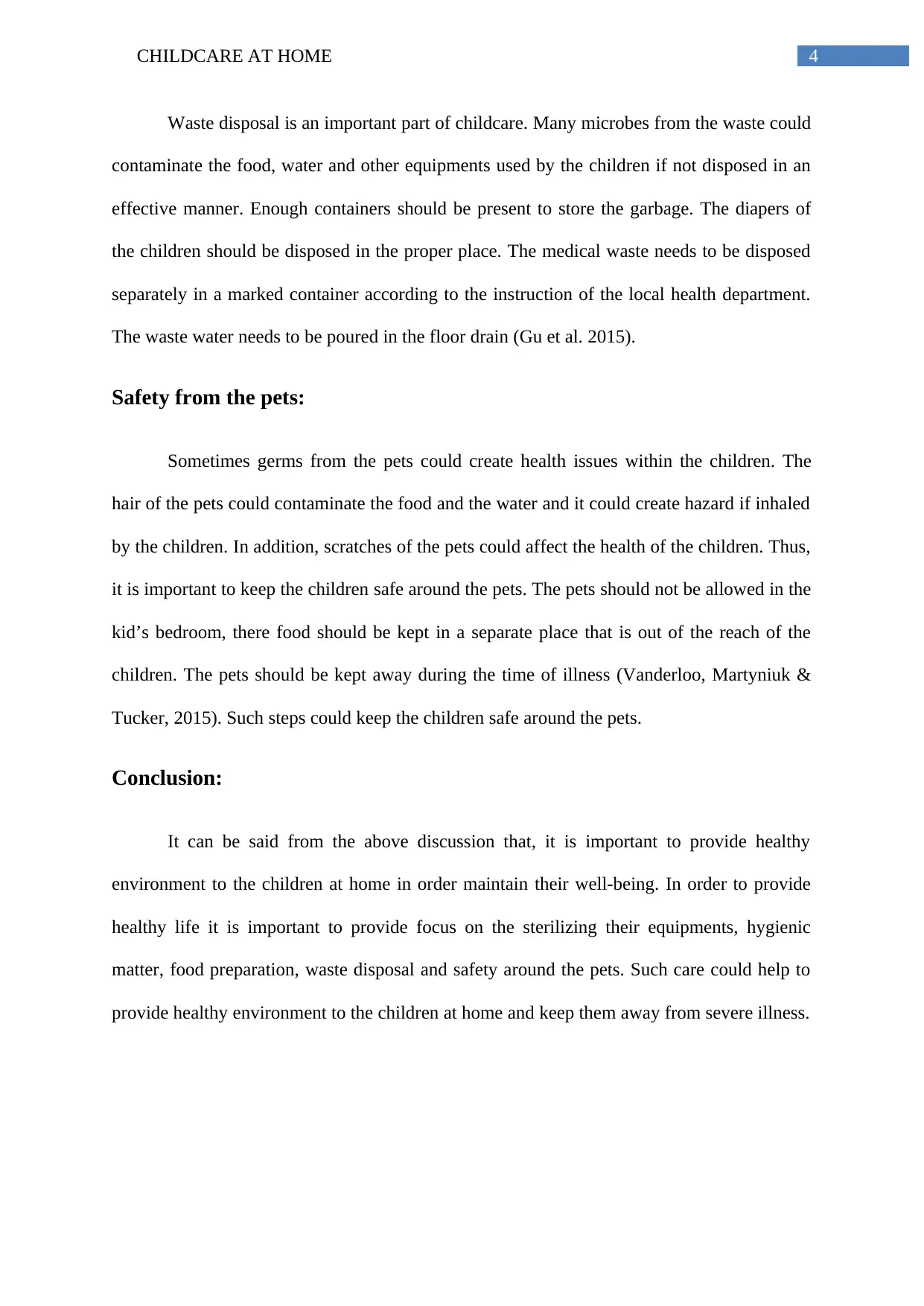
4CHILDCARE AT HOME
Waste disposal is an important part of childcare. Many microbes from the waste could
contaminate the food, water and other equipments used by the children if not disposed in an
effective manner. Enough containers should be present to store the garbage. The diapers of
the children should be disposed in the proper place. The medical waste needs to be disposed
separately in a marked container according to the instruction of the local health department.
The waste water needs to be poured in the floor drain (Gu et al. 2015).
Safety from the pets:
Sometimes germs from the pets could create health issues within the children. The
hair of the pets could contaminate the food and the water and it could create hazard if inhaled
by the children. In addition, scratches of the pets could affect the health of the children. Thus,
it is important to keep the children safe around the pets. The pets should not be allowed in the
kid’s bedroom, there food should be kept in a separate place that is out of the reach of the
children. The pets should be kept away during the time of illness (Vanderloo, Martyniuk &
Tucker, 2015). Such steps could keep the children safe around the pets.
Conclusion:
It can be said from the above discussion that, it is important to provide healthy
environment to the children at home in order maintain their well-being. In order to provide
healthy life it is important to provide focus on the sterilizing their equipments, hygienic
matter, food preparation, waste disposal and safety around the pets. Such care could help to
provide healthy environment to the children at home and keep them away from severe illness.
Waste disposal is an important part of childcare. Many microbes from the waste could
contaminate the food, water and other equipments used by the children if not disposed in an
effective manner. Enough containers should be present to store the garbage. The diapers of
the children should be disposed in the proper place. The medical waste needs to be disposed
separately in a marked container according to the instruction of the local health department.
The waste water needs to be poured in the floor drain (Gu et al. 2015).
Safety from the pets:
Sometimes germs from the pets could create health issues within the children. The
hair of the pets could contaminate the food and the water and it could create hazard if inhaled
by the children. In addition, scratches of the pets could affect the health of the children. Thus,
it is important to keep the children safe around the pets. The pets should not be allowed in the
kid’s bedroom, there food should be kept in a separate place that is out of the reach of the
children. The pets should be kept away during the time of illness (Vanderloo, Martyniuk &
Tucker, 2015). Such steps could keep the children safe around the pets.
Conclusion:
It can be said from the above discussion that, it is important to provide healthy
environment to the children at home in order maintain their well-being. In order to provide
healthy life it is important to provide focus on the sterilizing their equipments, hygienic
matter, food preparation, waste disposal and safety around the pets. Such care could help to
provide healthy environment to the children at home and keep them away from severe illness.
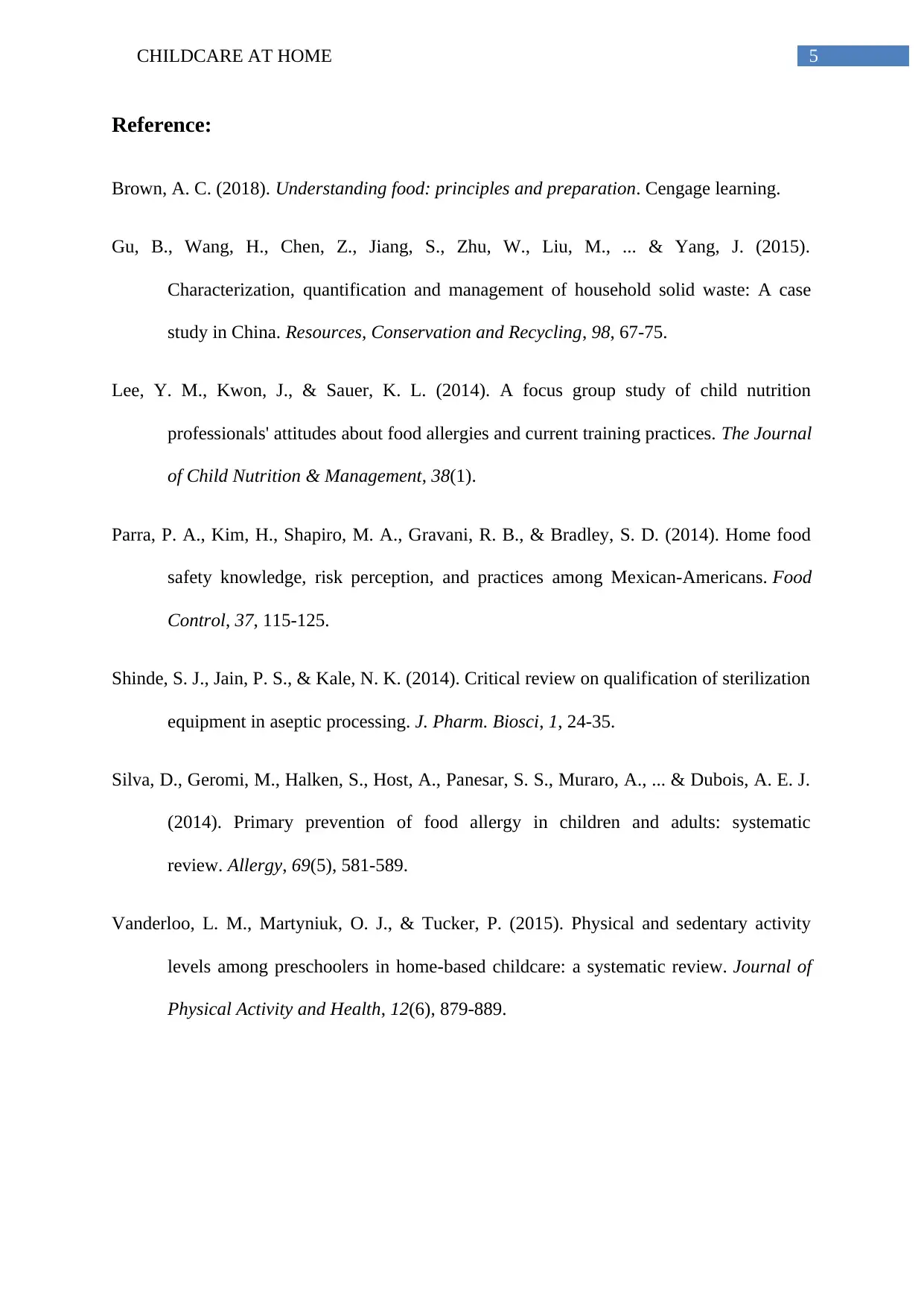
5CHILDCARE AT HOME
Reference:
Brown, A. C. (2018). Understanding food: principles and preparation. Cengage learning.
Gu, B., Wang, H., Chen, Z., Jiang, S., Zhu, W., Liu, M., ... & Yang, J. (2015).
Characterization, quantification and management of household solid waste: A case
study in China. Resources, Conservation and Recycling, 98, 67-75.
Lee, Y. M., Kwon, J., & Sauer, K. L. (2014). A focus group study of child nutrition
professionals' attitudes about food allergies and current training practices. The Journal
of Child Nutrition & Management, 38(1).
Parra, P. A., Kim, H., Shapiro, M. A., Gravani, R. B., & Bradley, S. D. (2014). Home food
safety knowledge, risk perception, and practices among Mexican-Americans. Food
Control, 37, 115-125.
Shinde, S. J., Jain, P. S., & Kale, N. K. (2014). Critical review on qualification of sterilization
equipment in aseptic processing. J. Pharm. Biosci, 1, 24-35.
Silva, D., Geromi, M., Halken, S., Host, A., Panesar, S. S., Muraro, A., ... & Dubois, A. E. J.
(2014). Primary prevention of food allergy in children and adults: systematic
review. Allergy, 69(5), 581-589.
Vanderloo, L. M., Martyniuk, O. J., & Tucker, P. (2015). Physical and sedentary activity
levels among preschoolers in home-based childcare: a systematic review. Journal of
Physical Activity and Health, 12(6), 879-889.
Reference:
Brown, A. C. (2018). Understanding food: principles and preparation. Cengage learning.
Gu, B., Wang, H., Chen, Z., Jiang, S., Zhu, W., Liu, M., ... & Yang, J. (2015).
Characterization, quantification and management of household solid waste: A case
study in China. Resources, Conservation and Recycling, 98, 67-75.
Lee, Y. M., Kwon, J., & Sauer, K. L. (2014). A focus group study of child nutrition
professionals' attitudes about food allergies and current training practices. The Journal
of Child Nutrition & Management, 38(1).
Parra, P. A., Kim, H., Shapiro, M. A., Gravani, R. B., & Bradley, S. D. (2014). Home food
safety knowledge, risk perception, and practices among Mexican-Americans. Food
Control, 37, 115-125.
Shinde, S. J., Jain, P. S., & Kale, N. K. (2014). Critical review on qualification of sterilization
equipment in aseptic processing. J. Pharm. Biosci, 1, 24-35.
Silva, D., Geromi, M., Halken, S., Host, A., Panesar, S. S., Muraro, A., ... & Dubois, A. E. J.
(2014). Primary prevention of food allergy in children and adults: systematic
review. Allergy, 69(5), 581-589.
Vanderloo, L. M., Martyniuk, O. J., & Tucker, P. (2015). Physical and sedentary activity
levels among preschoolers in home-based childcare: a systematic review. Journal of
Physical Activity and Health, 12(6), 879-889.
⊘ This is a preview!⊘
Do you want full access?
Subscribe today to unlock all pages.

Trusted by 1+ million students worldwide

6CHILDCARE AT HOME
1 out of 7
Your All-in-One AI-Powered Toolkit for Academic Success.
+13062052269
info@desklib.com
Available 24*7 on WhatsApp / Email
![[object Object]](/_next/static/media/star-bottom.7253800d.svg)
Unlock your academic potential
Copyright © 2020–2025 A2Z Services. All Rights Reserved. Developed and managed by ZUCOL.

